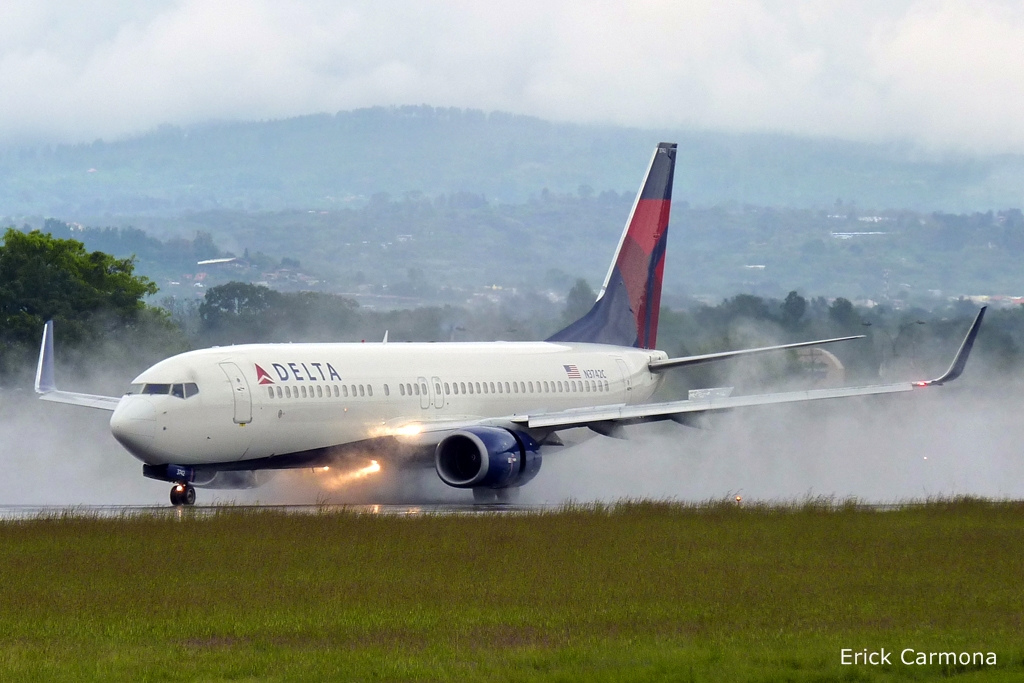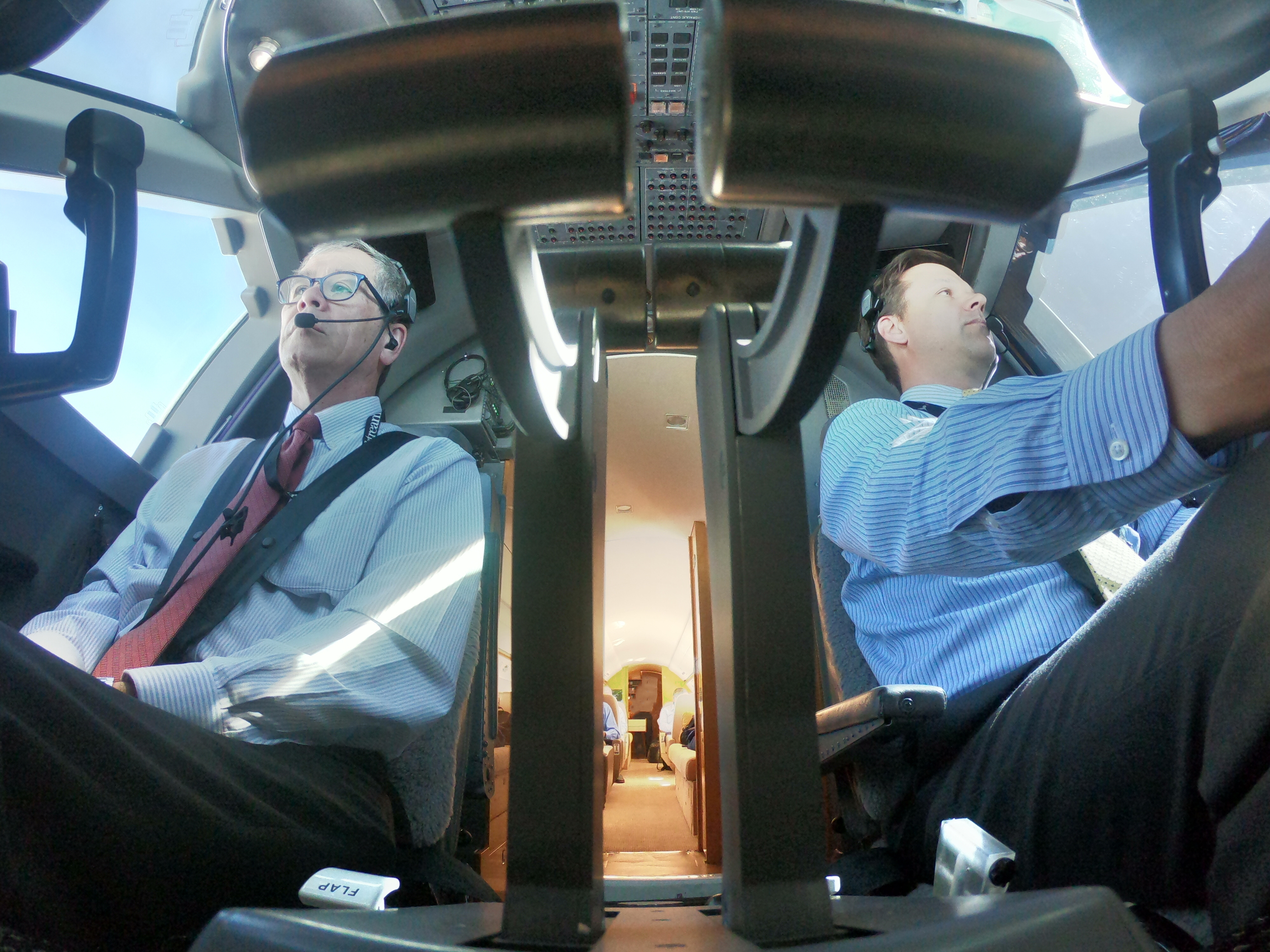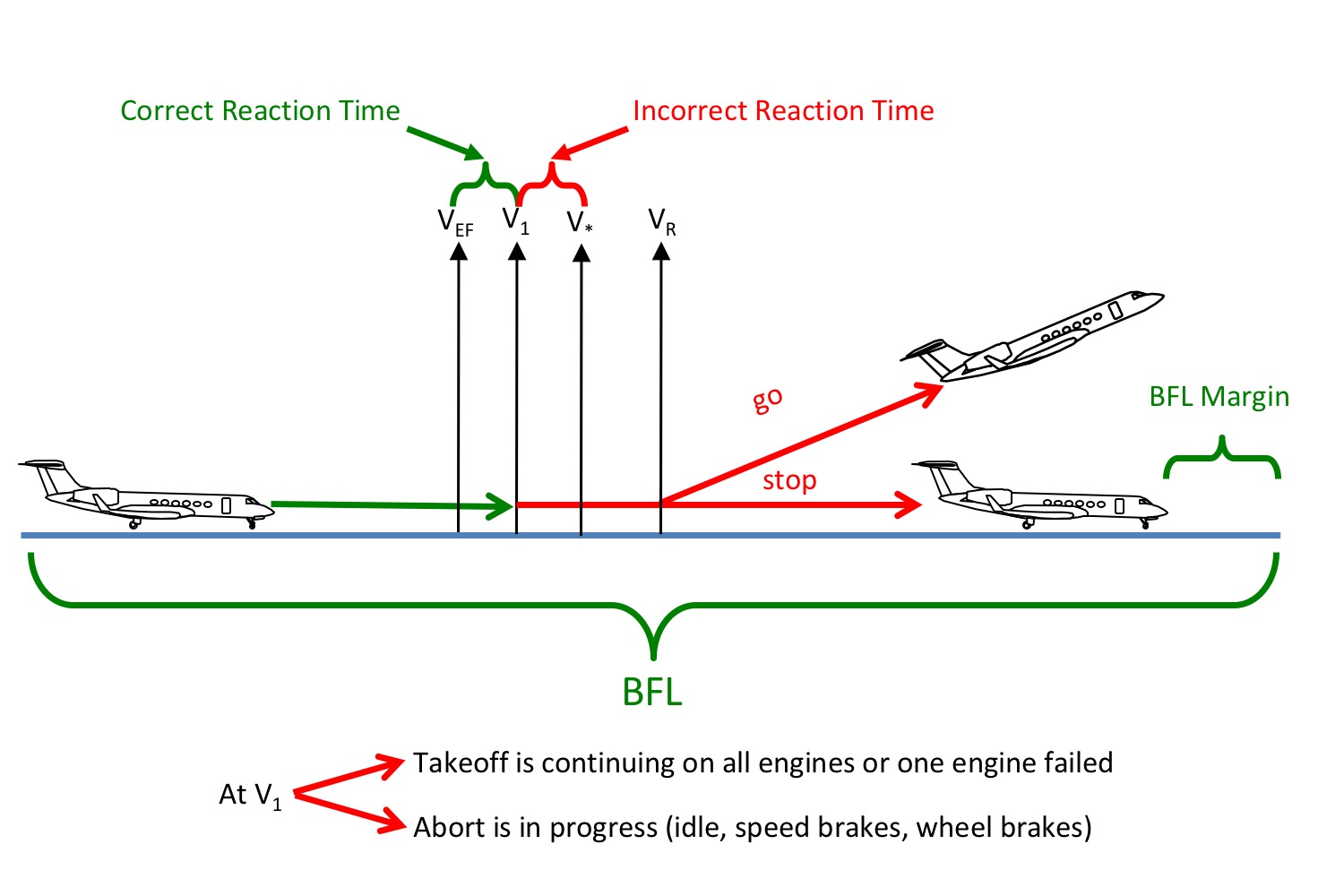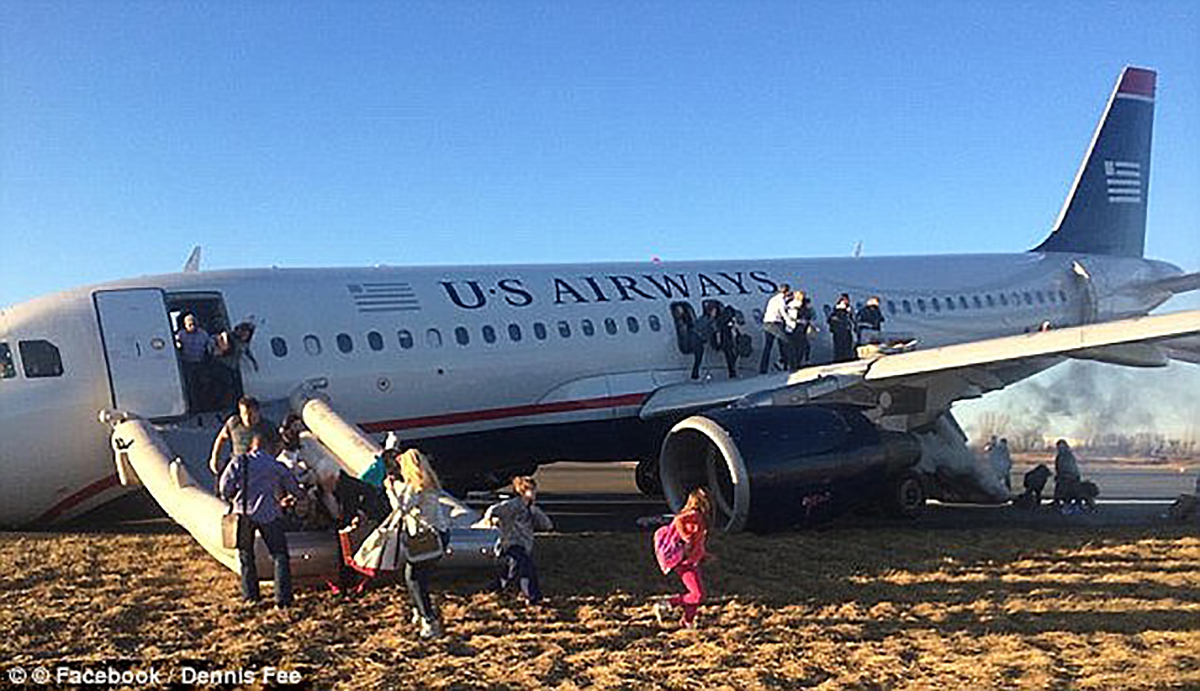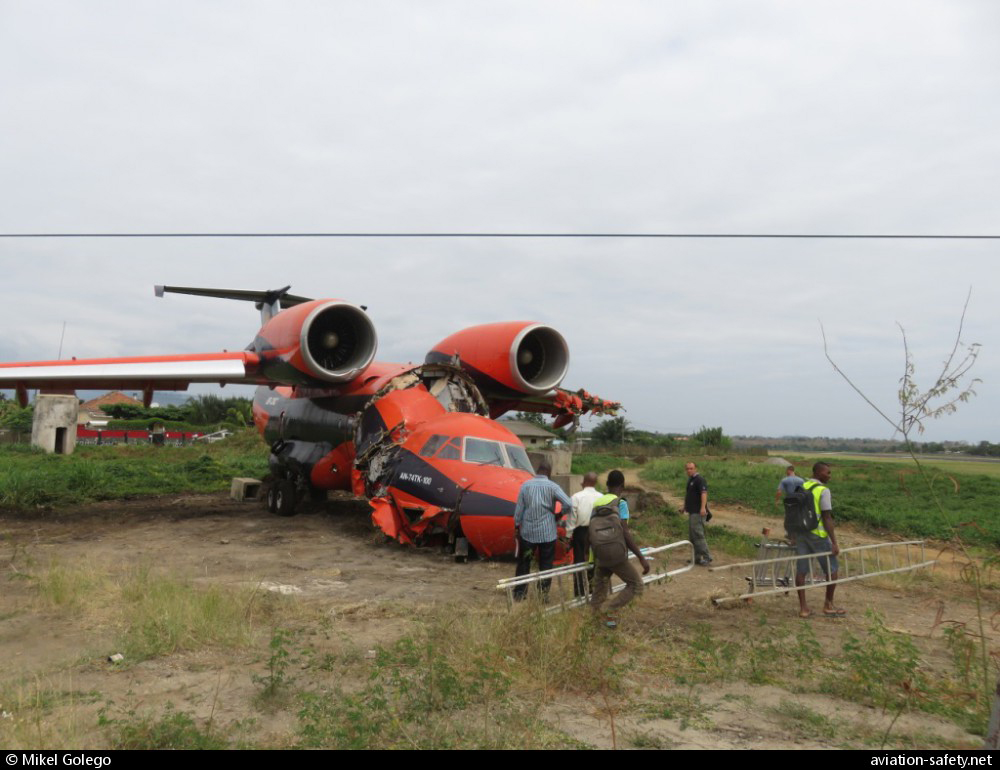If you are the Pilot in Command (PIC) and the Pilot Flying (PF) in the left seat, can the Second in Command (SIC) / Pilot Monitoring (PM) call abort? If he or she does that, will you abort?
— James Albright

Updated:
2019-04-19
Even more interesting (and controversial) is the opposite scenario. If you are the PIC / PM in either seat, can the SIC / PF initiate an abort without your consent?
You probably think both answers are obvious. You may be surprised that not everyone thinks you are right.
The answers depend more on who you are flying for than what you are flying. At one extreme, the captain has total and absolute abort authority and the first officer can do nothing more than offer an opinion. On the other extreme, both pilots can call for the abort and the other pilot must abort. Which way is right? It depends. So let's look at that.
Most of us experienced captains don't think there is any debate here at all, even if our view is diametrically opposed to the captain in the very next airplane. But consider:

1
Abort authority
The core of your abort authority philosophy is how much faith you are willing to place on your first officer versus how sure you are that the captain can make a timely decision in either PF or PM role. If you are in a situation where the captain has lots of experience and the first officer has only a little, then your choice may be cut and dried. But even in this "ideal" situation, there are costs measured in seconds. And those seconds can be crucial.
Abort Authority / Advisory:
There are three basic models to describe who has abort authority in a two-pilot cockpit crew.
Captain has complete abort authority / First officer only allowed to announce nature of problem
Many major airlines use this philosophy, but it can also be found in corporate flight departments.
Pros: No confusion about who is making the decisions.
Cons: A possible delay in decision making if the first officer is the first to detect a problem, can lead to unnecessary high speed aborts.
Captain can always call for abort / First officer can only call own abort
Some airlines and most regional airlines seem to have adopted this philosophy.
Pros: No confusion who is making the decision, faster execution if the first officer detects a problem and executes the abort without waiting for the captain's approval.
Cons: A possible delay in decision making if the first officer is the pilot monitoring, a possible faulty decision if the lesser experienced first officer is making the takeoff and the decision.
Either pilot can call for the abort and must execute abort when called
A few airlines use this philosophy, it is the prevalent philosophy for most corporate flight departments with highly experienced pilots.
Pros: Very quick decision making.
Cons: Can lead to timid decision making if the pilot flying is junior to and intimidated by the pilot monitoring.
Power Levers:
You can tell a lot about a crew's abort philosophy by the way they handle the power levers on most aircraft. There are exceptions, of course. In a Boeing 747, for example, the aircraft can be steered with equal effectiveness from either side of the cockpit. The most important element of this philosophy is who is allowed to say the word "abort" or "reject" and what happens next.
Captain controls power levers from brake release, gives up control once airborne if it is the first officer's leg
This model is used by several major airlines.
Pros: No delays from decision to execution if captain is the pilot flying.
Cons: A delay is imposed when the first officer is the first pilot noticing the need to abort.
Captain gives up control at some point prior to V1 if it is the first officer's leg
This model is used by many airlines and some corporate flight departments.
Pros: Fewer delays from decision to execution, provided the first officer has abort authority.
Cons: Can lead to confusion if the first officer has the power levers without abort authority.
Pilot Flying has control during entire duration of takeoff
This model seems to be preferred by many corporate flight departments.
Pros: No delays from decision to execution if both pilots have abort authority.
Cons: Can lead to confusion if either pilot disagrees with the actions taken if either pilot can call the abort.
2
High speed abort risk versus abort authority
It seems what I am most concerned about here is the delay between the decision and execution but that is only partially true. The bigger problem is that delay imposes on us as captains (and first officers with abort authority) the necessity to make the right decision in less time if there is a delay.
So what's the big deal? We've got two seconds and two seconds is a long time. Well, you don't have two seconds and even if you did, it isn't enough. Let's get into the math, but let's try to make the math obvious while we are at it.
How much time do you really have?
From a regulatory standpoint, there is no specified decision making time. But the decision must have already been made by V1:
V1 means the maximum speed in the takeoff at which the pilot must take the first action (e.g., apply brakes, reduce thrust, deploy speed brakes) to stop the airplane within the accelerate-stop distance. V1 also means the minimum speed in the takeoff, following a failure of the critical engine at VEF, at which the pilot can continue the takeoff and achieve the required height above the takeoff surface within the takeoff distance.
Source: 14 CFR §1.1
The pilot flying cannot react properly to V1 unless the V1 call is made in a timely, crisp, and audible manner. One method of accomplishing this by a major U.S. carrier is their adoption of a policy of “completing the V1 callout by the time the airplane reaches V1.” This is an excellent example of the way airlines are implementing procedures to improve RTO safety. It is a good procedure and it should preclude a situation where the “No Go” decision is inadvertently made after V1.
Source: Takeoff Safety Training Aid, ¶2.3.6.9
So where does the so-called two seconds come from? From here:
Accelerate-stop distance.
(a) The accelerate-stop distance on a dry runway is the greater of the following distances:
(1) The sum of the distances necessary to—
(i) Accelerate the airplane from a standing start with all engines operating to VEF for takeoff from a dry runway;
(ii) Allow the airplane to accelerate from VEF to the highest speed reached during the rejected takeoff, assuming the critical engine fails at VEF and the pilot takes the first action to reject the takeoff at the V1 for takeoff from a dry runway; and
(iii) Come to a full stop on a dry runway from the speed reached as prescribed in paragraph (a)(1)(ii) of this section; plus
(iv) A distance equivalent to 2 seconds at the V1 for takeoff from a dry runway.
(2) The sum of the distances necessary to—
(i) Accelerate the airplane from a standing start with all engines operating to the highest speed reached during the rejected takeoff, assuming the pilot takes the first action to reject the takeoff at the V1 for takeoff from a dry runway; and
(ii) With all engines still operating, come to a full stop on dry runway from the speed reached as prescribed in paragraph (a)(2)(i) of this section; plus
(iii) A distance equivalent to 2 seconds at the V1 for takeoff from a dry runway.
Source: 14 CFR §25.109
It may seem like we are splitting hairs here; isn't two seconds at V1 the same as two seconds at the end of the takeoff run when, just before you come to a complete stop? It is not, and learning this shows just how thin the margins can be.
The two seconds at V1 is converted into a distance that is added to the end of your takeoff run once you've come to a complete stop. It is nothing more than a safety margin. That distance is determined by your speed at V1. That speed should be your top speed achieved during the acceleration to the point at which you begin slowing down. Every millisecond you continue accelerating, you are (1) eating into that safety margin and (2) invalidating the math because you are accelerating.
Let's say you are taking off in a Gulfstream GV on a balanced field at maximum weight on an ISA day at sea level. If you begin the abort right at V1, you should have just over 400 feet in front of you when you come to a complete stop, based on having two seconds margin at your top speed of 130 knots when you began the abort. Starting the abort two seconds after V1 adds 500 feet to your distance. You are now off the runway. For the math, see: V1 Dynamics.
But wait, you say, your manufacturer says you have two seconds. They might. My manufacturer (Gulfstream) varies reaction time from as little as 1.00 second to as much as 1.25 seconds. Whatever your manufacturer says, the reaction time comes before V1. More about this: V1.
How much time does it really take?
So it is clear you don't have a lot of time to make your decision, as little as 1.00 second, depending on your manufacturer. Furthermore, this decision must be completed before V1. So how long does it take to make a decision in the most obvious case of an engine failure? (I say obvious because it is the one we practice the most.)
In 2010, the National Aerospace Laboratory (NLR) of the Netherlands issued a study of high speed rejected takeoffs by analyzing accidents and serious incidents before and after a 1993 joint industry study, led by Boeing, known as the Takeoff Safety Training Aid. The study found that accident/serious incident rate of high speed rejected takeoffs had dropped by 24% but were still too high.
Each takeoff includes the possibility that the pilot needs to stop the aircraft and reject the takeoff. Analysis of pilot reported rejected takeoffs occurrences showed that the rejected takeoff manoeuvre occurs approximately once in every 1800 takeoffs (source: NLR-ATSI). With this rate a pilot who flies primarily longhaul routes, may be faced on average with a rejected takeoff only once in 25 years. In contrast, a pilot on a regional jet may face a rejected takeoff every 4 years on average. The pilots in each of these fleets must be prepared to make an RTO decision during every takeoff. Even to the regional pilots it will not be a common thing to do other than in the simulator. Analysis of pilot reported rejected takeoffs occurrences showed that about 56% of the rejected takeoffs occurred at speeds lower than 60 kt. and almost 90% below 100 kt. (source: NLRATSI). Even if a pilot faces the decision to reject it is most likely at a low speed. To reject a takeoff at high speeds is very rare.
Source: NLR, p. 7
Some operators and aircraft manufactures have defined a speed up to which a takeoff should be rejected for all observed failures or warnings. Above this speed and to the takeoff decision speed V1, the takeoff should be rejected only in case of an engine failure and conditions affecting the safe handling of the aircraft. However amongst the operators different policies exist regarding these takeoff rejection criteria. The speed up to which a takeoff should be rejected for all observed failures, varies between 70-100 Kt. with a typical value of 80 Kt. or 100 Kt.
Source: NLR, p. 9
In the high-speed regime, the pilot's bias should be to continue the takeoff, unless there is a compelling reason to reject.
Source: NLR, p. 9
The study concludes, however, that in many cases pilots make an incorrect decision to abort:
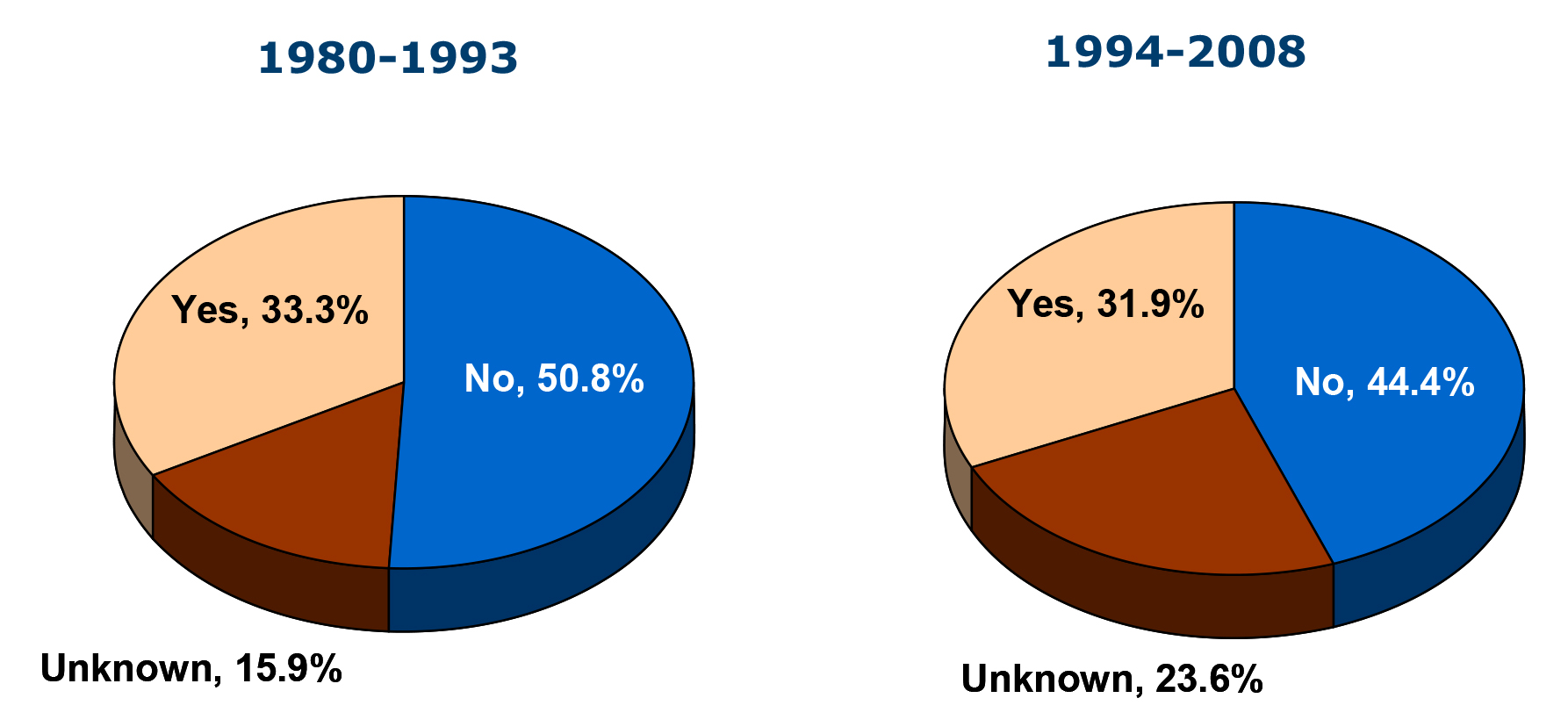
Correct decision to abort or not, NLR ATSI, fig. 3
The study did not speculate as to why we are getting (marginally) better but I suspect it has mostly to do with better simulator training and cockpit electronics that inhibit nuisance warnings at higher speeds. But the fact we continue to get nearly half of these decisions wrong is worrisome. Most of us employ two-stage abort criteria, typically saying we will only abort for critical items above 80 or 100 knots. The report states the obvious that these decisions are easy at lower speeds. But when the runway is racing by at 200 feet per second (120 knots), it is no wonder the decision becomes more difficult nearing V1.
A simulator study conducted by Qantas gave some interesting facts about decision and reaction times of pilots during rejected takeoffs (Qantas, 1970). In this study the pilots conducted a normal takeoff. However, they were not informed that an engine failure would occur just before V1. Some of the important results of this study are shown in figure 5. These data show that the time between the engine failure and pilot’s reaction can be very long.
Source: NLR, p. 17
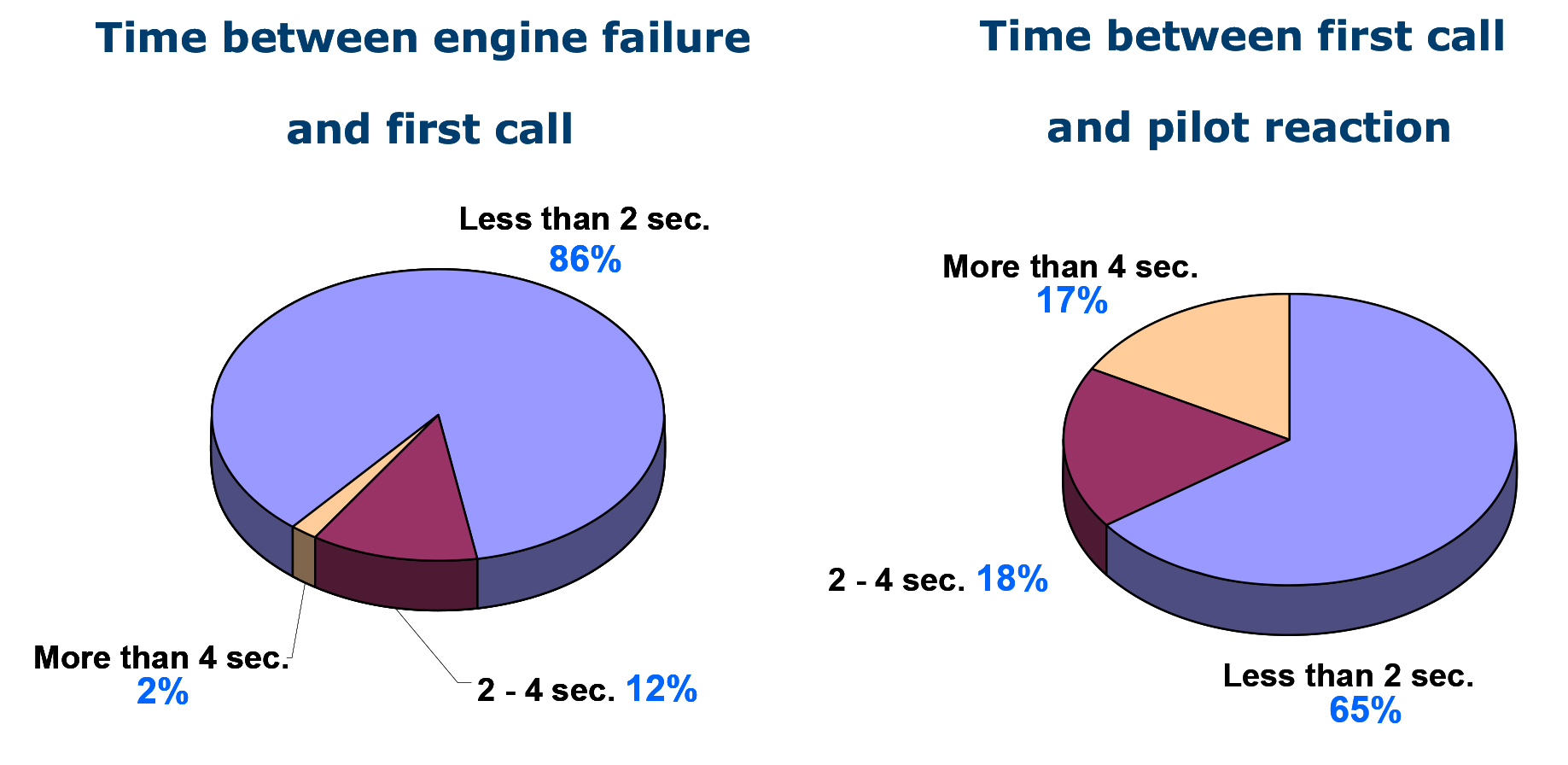
Reaction times after an engine failure, NLR ATSI, fig. 5
We can take away a few conclusions:
- For the most part, we do indeed react very quickly (in less than 2 seconds) when it comes to recognizing the problem and making the abort callout.
- We also react to the callout fairly quickly (in less than 2 seconds) when it comes to reacting to this callout.
- If the person making the callout does not have abort authority, you potentially double the time needed before action is taken.
For the sake of argument, let's say we have a sharp crew and our reaction time is 1 second for evaluating the problem and making the callout. We will also say our pilots are on their game and it only takes 1 second to initiate the abort. So, in theory, we can go from problem to abort in 2 seconds. Consider a few hypotheticals where the first officer does not have abort authority:
- If the captain is the pilot flying (attention is outside) and the first officer is monitoring crew alerting systems (attention inside) — If the issue is apparent from outside the cockpit, it takes the captain 1 second to evaluate and decide to abort, and 1 second to react, for a total of 2 seconds between problem and abort initiation.
- If the captain is the pilot flying (attention is outside) and the first officer is monitoring crew alerting systems (attention inside) — If the issue is apparent from inside the cockpit, it takes the first officer 1 second evaluate and make the callout, the captain 1 second to evaluate the callout, and 1 second to react, for a total of 3 seconds between problem and abort initiation.
- If the first officer is the pilot flying (attention is outside) and the captain is monitoring crew alerting systems (attention inside) — If the issue is apparent from inside the cockpit, it takes the captain 1 second evaluate and make the callout, the first officer 1 second to evaluate the callout, and 1 second to react, for a total of 3 seconds between problem and abort initiation.
- If the first officer is the pilot flying (attention is outside) and the captain is monitoring crew alerting systems (attention inside) — If the issue is apparent from outside the cockpit, it takes the first officer 1 second to evaluate the problem and 1 second to make the callout, it then takes the captain 1 second look up, evaluate and make the abort callout, the first officer 1 second to evaluate the callout, and 1 second to react, for a total of 5 seconds between problem and abort initiation.
Of course you can argue the captain might spot the problem as quickly as the first officer or that the captain could decide to initiate the abort while simultaneous making the callout. There can be a number of variations, but not allowing the first officer to make the decision or initiate the abort will cost time. I think we all understand this situation lengthens the time needed to initiate the abort and this puts enormous pressure on the captain to make these decisions quickly.
A study from the NTSB has suggested that difficulties and delays could occur when transferring the control of the aircraft from the F/O to the captain (as required by many airline's operating procedures). This could add up to the total time of detecting a problem and reacting on it. In the present occurrence data it could not always be established who the pilot flying was and if there was a transfer of controls. The control transfer could be limited to directional controls only in the case that the captain is responsible (by SOP) for handling the thrust levers regardless if the captain is the pilot flying or not. A simulator study conducted by Boeing [Roberson and Shontz, (1992)] showed that the exchange of aircraft control influences the stopping performance during an RTO. The study concluded that if the FO calls and executes the RTO the margins in remaining runway length during an RTO are the lowest. Based on these results Boeing recommended that the Capt. should call and execute all RTOs.
Source: NLR, p. 19
I don't see how this is possible. My conclusion is this: a highly qualified first officer with the necessary decision making ability should be able to call for the abort and should be able to execute the abort. If, however, the first officer does not have the necessary experience, the captain should call and execute the abort.
What is the cost of delay?
All these above mentioned issues with reaction times illustrate that pilots need time to assess complex situations and to react upon them. With a typical acceleration of 3 to 6 knots per second, just 3 seconds for assessing the situation and decision-making, will add 9 to 18 knots to the speed. If the aircraft is close to V1, it now most likely has exceeded it.
Source: NLR, p. 19
There are only a few documented instances where an abort decision is made, disputed, or reversed. You could argue that these instances are more about Crew Resource Management than abort authority. I believe the best way to examine the cost of having the wrong abort authority philosophy is to look at takeoff aborts where the problem may have been made before V1 and would have been better handled with a "go" decision, but the delays in reaction timing resulted in an abort initiated above V1.
3
Case studies
A high speed abort happens very quickly and usually as a result of something else going wrong. It may seem unfair to second-guess a crew's actions when the decisions came very quickly and the causal factors can be interrelated. But we should look at a few cases just to stimulate the thought process needed to evaluate our own abort authority philosophy.
Absolute authority can instill in the captain the feeling SOPs are optional: Kalitta 207
"It is lonely at the top," or so the saying goes. But once a captain becomes entrenched into the system and is rarely questioned, decision making skills tend to atrophy. If nobody ever second guesses you on the little things, which happen frequently, then you may be less likely to consider that your first reaction to a big thing could be wrong. Of course this is pilot psychology and we cannot get into the heads of pilots post-accident. But in my opinion, the captain of Kalitta 207 was not at the top of his game when he destroyed a perfectly flyable Boeing 747. The Kalitta General Operating Manual placed 100% of the abort authority on his shoulders. I think if the airline's CRM allowed more questioning from the rest of the crew, this captain's decision making would have been sharper. In this particular accident, the captain acted faster than the crew could react. But I think if he were used to operating in an environment where his actions could be questioned routinely, he would not have acted so rashly.
More about this: Case Study: Kalitta Air 207.
When a first officer has no authority, CRM is handicapped: US Air 1702
So what's wrong with a strong captain who is assertive and doesn't entertain a lot of "back and forth" in the cockpit? If that captain never makes a mistake, I suppose the only problem is that you end up with meek and timid first officers. But if the captain does make a mistake, you can end up with perfectly good airplanes crashing when a more assertive first officer could have stopped the accident chain earlier. In this case, the first officer's initial and minor mistake cascaded into an accident because the captain made many more mistakes and then panicked at the worst possible moment.
More about this: Case Study: US Air 1702
Regardless of who has abort authority, the dangers of a high speed abort must be appreciated: Cavok Air 7087
I think many of us "highly seasoned" captains have become so confident in our abilities that we may not really embrace our SOPs the way our younger peers have. When we are younger we might have taken the company SOPs with more enthusiasm but there is a temptation when you get older to think you know more than the people writing the SOPs. If you never have to justify your actions to the crew, you soon think your actions cannot be wrong.
More about this: Case Study: Cavok 7087
CRM works even when a high speed abort is necessary: Ameristar 9363
So having a captain making a rash, last-second decision to abort is a bad thing. Yes. But captains and first officers alike need to understand that if the airplane will not fly, you have to abort and follow your abort procedures precisely. Here is a brilliant example.
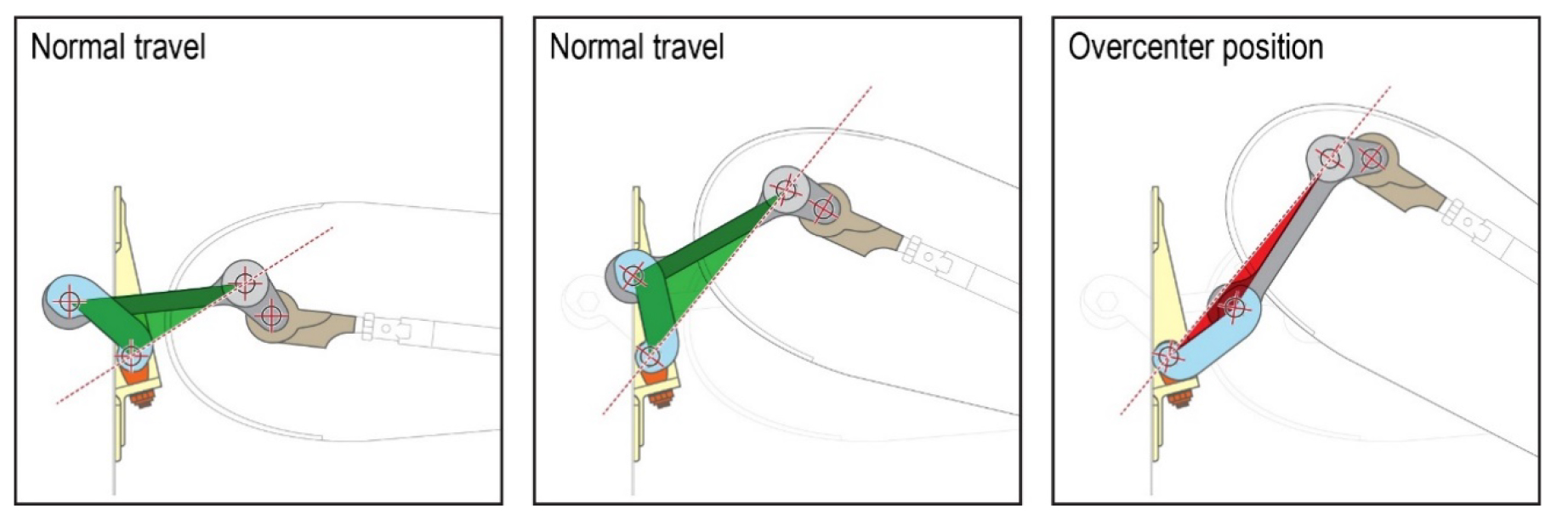
Diagram showing relative positions of the links (blue) and actuating crank (gray) when moving within their normal range of travel (in green) and when locked overcenter after having moved beyond their normal range of travel (in red), NTSB AAR 19/01, figure 7
The crew of the MD-83 did everything right, from crew briefings, the preflight, flight control checks, you name it. But gusty winds jammed one of two elevators in the full nose down position. The design of the airplane's flight control system made it impossible for the crew to detect the jam until attempting to rotate. The captain was the pilot flying but he wasn't the pilot in command. (He was upgrading to captain.) The first officer was the pilot monitoring but was also a check airman. Under some companies, only the check airman would have abort authority. But in this case, the other pilot called for and initiated the abort. Both pilots reacted according to SOP to get the airplane to this point, their crew coordination remained exemplary throughout and they did their best to abort the takeoff once that became their only option. The NTSB points out that had that not been the case, the results would have been catastrophic. You can give both pilots abort authority and provide for effective takeoff aborts, even of the high speed variety.
More about this: Case Study: Ameristar 9363
4
It depends
So, up for debate: which abort philosophy is best? Should the captain have absolute authority while allowing the rest of the crew only the power to recommend? Or should the rest of the cockpit crew be allowed to say "Abort!" and expect the pilot flying to do just that? As with many things in aviation, the answer is "it depends."
In my opinion . . .
- When simulator training is unavailable and a first officer's experience is limited, it may be appropriate to withhold abort authority during operational flying. In this case, it would be wise to require the captain fly every takeoff when close to a balanced field condition and emphasize to the first officer that any callouts must be short, succinct, and forceful. For example: "Overtemp, right engine" and not "I think the right engine has a problem."
- When simulator training is available, first officers should be well schooled on the dangers of a high speed abort and the need to become "go oriented" at higher speeds except for specific instances the manufacturer or operator agree on. At our company, for example, we would condone an abort above 80 knots and below V1 for a loss of directional control, a fire anywhere on the aircraft, or other conditions that make the aircraft unflyable.
- Once a first officer becomes fully qualified (either through an aircraft or simulator training program), he or she should have abort authority. The first officer should be allowed to call for the abort and, if acting as the pilot flying, should be able to initiate the abort. The captain should initiate the abort when the first officer calls it out.
Let the hate mail begin. I grew up flying crew aircraft under the philosophy that only the captain has abort authority. Our simulators were laughable by today's standards and we did most of our training in the aircraft. But once I progressed to the Boeing 747 we adopted a two-stage abort philosophy (one at 100 knots the other at V1) and we fully embraced the "go oriented" idea that discouraged high speed aborts.
5
Mail bag
James,
I very much enjoyed your article on the calling of a stop on an RTO in B&CA June 2019. As always, thought provoking stuff.
I have left the post of Chief Pilot one of the UK's largest management companies, however a few years ago we wrestled with the question of who calls "Stop" during the takeoff roll.
Those of us with airline backgrounds such as myself were in favour of the traditional approach of any problem being articulated by the right seat pilot with the left seat pilot making the decision whether or not to stop.
However we decided against this and mandated an 'either pilot call stop' policy because of these reasons, some of which you may have overlooked in your article:
- not all our crews have English as a first language and identifying a problem and then articulating this in English when under stress is asking too much in a short time;
- business jets accelerate much quicker than transport aircraft meaning decisions have to be taken quicker;
- we want all our First Officers to take responsibility and think as Captains early on;
- we mostly fly as co-captains, (as in most business jet operations), not as Captain/First officer, so both are highly experienced and able to make the call;
- It's not an easy decision who does what and any SOP needs careful study. It depends on whether its a limiting runway; a traditional Captain/FO combination; both pilots are fluent English speakers; the experience level of the pilots etc etc.
RTOs are not discussed as much as they should be, thanks for raising the subject.
Keep up the good work.
References
(Source material)
14 CFR 1, Title 14: Aeronautics and Space, Definitions and Abbreviations, Federal Aviation Administration, Department of Transportation
14 CFR 25, Title 14: Aeronautics and Space, Airworthiness Standards: Transport Category Airplanes, Federal Aviation Administration, Department of Transportation
Advisory Circular 120-62, Takeoff Safety Training Aid, 9/12/94, U.S. Department of Transportation
Gulfstream G450 Airplane Flight Manual, Revision 35, April 18, 2013
Gulfstream GV Airplane Flight Manual, Revision 30, 13 May 2008
FAA Takeoff Safety Training Aid, April 2, 1993
NTSB Aircraft Accident Report, AAR-19/01, Runway Overrun During Rejected Takeoff, Ameristar Air Cargo, Inc., dba Ameristar Charters, flight 9363, Boeing MD-83, N786TW, Ypsilanti, Michigan, March 8, 2017
Rejecting a Takeoff after V1 ... Why Does it (Still) Happen, NLR Transportation Safety Institute, NLR-TP-2010-177, April, 2010, G. W. H. van Es
Please note: Gulfstream Aerospace Corporation has no affiliation or connection whatsoever with this website, and Gulfstream does not review, endorse, or approve any of the content included on the site. As a result, Gulfstream is not responsible or liable for your use of any materials or information obtained from this site.
